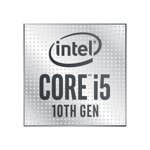Intel Core i5-10600K (10600KF)
CPUProduct Gallery

Product Overview
Intel Core i5-10600K is a mid-range desktop PC microprocessor in Intel's 10th-gen Core, Comet Lake family. A K-series processor, it is unlocked and therefore one of the few Intel CPUs that can be overclocked.
The Core i5-10600K processor comes with 6 cores and 12 threads and a single-core maximum frequency of 4.8GHz. It sports the same Intel UHD Graphics 630 integrated GPU found in earlier Coffee Lake processors.
Alongside the i5-10600K, Intel also markets the Core i5-10600KF. The "F" designation means the i5-10600KF does not come with the integrated graphics. Intel debuted this concept in 2019 in order to salvage chips with defective GPUs that are otherwise perfect. As a result, the i5-10600KF shares with the i5-10600K all specifications except for the difference in integrated graphics. For desktop users with discrete graphics installed, the F-series chip may be an interesting option, thanks to its lower MSRP.
As a third refinement based on the 14nm Skylake process, the Comet Lake desktop processors offer an increase in core count, clock speed, and cache capacity over its predecessor. All Comet Lake Core processors feature hyperthreading, allowing two threads to run on every core.
Ratings
What we found
Pros
- Extremely fast gaming performance
- Excellent overclocking options
Cons
- More expensive than the Core i5-10600K
What external reviewers found
External score 80%
Pros
- Great single-core and multi-core performance
- Excellent overclocking performance
- Great value for money
- Great performance in single-threaded applications
- Competitive price
Cons
- No bundled cooler
- No integrated graphics
- No PCIe 4.0
- Higher per-core cost than Ryzen 7 3700X
- No Hyper-Threading
Your rating:
12345678910
?/10
Price Comparison
As associates of the merchants above, we earn a commission when you make a purchase using the supplied links.
Specifications
[{"Ft":"Connectivity","Fn":"CPU Socket","Fv":"FCLGA1200"},{"Ft":"Connectivity","Fn":"PCI Express","Fv":"16 lanes of 3.0 (1x16, 2x8, or 1x8 + 2x4)"},{"Ft":"Construction","Fn":"Form Factor","Fv":"Desktop microprocessor"},{"Ft":"Construction","Fn":"Lithography","Fv":"14 nm"},{"Ft":"Construction","Fn":"Platform","Fv":"Comet Lake"},{"Ft":"Dimensions","Fn":"Size | Depth","Fv":"37.5 mm"},{"Ft":"Dimensions","Fn":"Size | Width","Fv":"37.5 mm"},{"Ft":"Function","Fn":"Graphics","Fv":"Intel UHD Graphics 630, base 350MHz, boost 1.2GHz, max memory 64GB"},{"Ft":"Function","Fn":"Operating Temperature","Fv":"Max 100°C T Junction"},{"Ft":"Function","Fn":"Processor | Cores","Fv":"6 cores"},{"Ft":"Function","Fn":"Processor | Threads","Fv":"12 threads"},{"Ft":"Function","Fn":"Resolution","Fv":"Max Resolution 4K DCI (4096 x 2304@60Hz via DP / 4096 x 2304@30Hz via HDMI)"},{"Ft":"Function","Fn":"Security","Fv":"Intel AES New Instructions, Secure Key, Intel OS Guard, Intel Trusted Execution, Intel Boot Guard"},{"Ft":"Function","Fn":"Supported Technologies","Fv":"Intel Optane Memory, Intel vPro, Intel Hyper-Threading Technology, Intel Virtualization Technology, Enhanced Intel SpeedStep Technology"},{"Ft":"Function","Fn":"Thermal Solution","Fv":"PCG 2015D"},{"Ft":"Performance","Fn":"Cache","Fv":"12 MB Intel Smart Cache"},{"Ft":"Performance","Fn":"Frequency","Fv":"4.1 GHz Base | 4.8 GHz single core / 4.5 GHz all cores Turbo"},{"Ft":"Performance","Fn":"Memory | Capacity","Fv":"Supports up to 128GB"},{"Ft":"Performance","Fn":"Memory | Type","Fv":"DDR4 2666MHz, max 2 channels, max 41.6 GB/s bandwidth"},{"Ft":"Performance","Fn":"Power Consumption","Fv":"95 W TDP"},{"Ft":"Production","Fn":"Debut","Fv":"2020 Q2"}]
Related Articles
External Reviews
pcmag[1]
Reviewer score 69% (normalized by Neofiliac)The Intel Core i5-10600K is likely going to debut at somewhere around $275 to $300. It's more than twice as expensive as the Ryzen 3 3300X, while performing an average of only 11 percent faster in gaming tests. AMD proves that its 7nm-based Zen 2 processors are consistently the better value in multi-thread-heavy content crunching.
Pros
- Competitive gaming performance for the price
- Competitively priced
Cons
- Higher per-core cost than Ryzen 7 3700X
- No bundled cooler
techradar[2]
Reviewer score 87% (normalized by Neofiliac)The Intel Core i5-10600K is a massive improvement over the Core i9-10900K. Both single-core and multi-core performance gets a huge bump, while power consumption also sees a massive increase. The inclusion of Hyper-Threading on a K-series processor will help this processor have more utility than just a gaming chip. However, it's not all rosy here. Intel Comet Lake-S doesn't support PCIe 4.0, which means the latest and greatest NVMe SSDs are incompatible.
Pros
- Great single-core and multi-core performance
- Hyper-Threading is a huge improvement
Cons
- No PCIe 4.0
tomshardware[3]
Reviewer score 87% (normalized by Neofiliac)The six-core, twelve thread Core i5-10600K ticks at a 4.1 GHz and 4.8 GHz boost. Unlike the Core i9 models, Intel doesn't include it's complicated matrix of TurboBoost 3.0 Max and Thermal Velocity Boost (TVB) clock rates. Pricing is competitive, especially with the $25 discount for picking the graphics-less 10600KF model. Just don't expect to do any meaningful gaming without a dedicated graphics card.
Pros
- Great value for the money
- Excellent overclocking performance
- Competitive price
Cons
- No integrated graphics
trustedreviews[4]
Reviewer score 78% (normalized by Neofiliac)-10900K, which is twice as expensive – at most, the cheaper Intel part only lost a frame when compared with its pricier stablemate. That bodes well for using the i5-10600K in a gaming rig – you’re not going to lose much speed. In games, it’s almost on a par with a Core i9 chip when it comes to real-world speed. The Core i5's higher speeds and move to Hyper-Threading mean that this chip isn’t particularly frugal.
Pros
- Great performance in single-threaded applications
- Great value for money
Cons
- No Hyper-Threading
References
<
>
x
